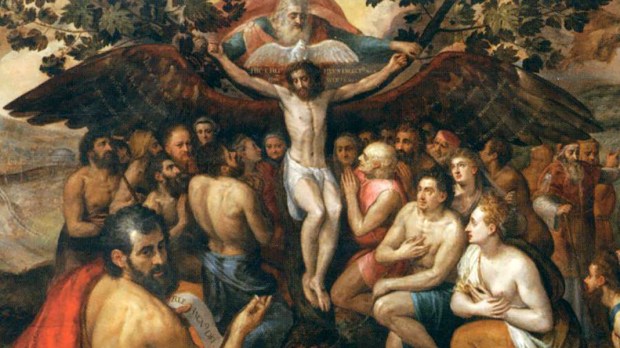Lenten Campaign 2025
This content is free of charge, as are all our articles.
Support us with a donation that is tax-deductible and enable us to continue to reach millions of readers.
What do you feel when you look at a crucifix? What is your personal response? Do you feel horror, guilt and shame at man’s inhumanity? Or are you inspired to feel admiration and love for a savior who willingly subjected Himself to suffering?
The following are three paintings that can help you explore your emotional response to the crucifixion of Jesus and come closer to Him in these last days of Lent and beyond.
1The Pazzi Crucifixion by Pietro Perugino
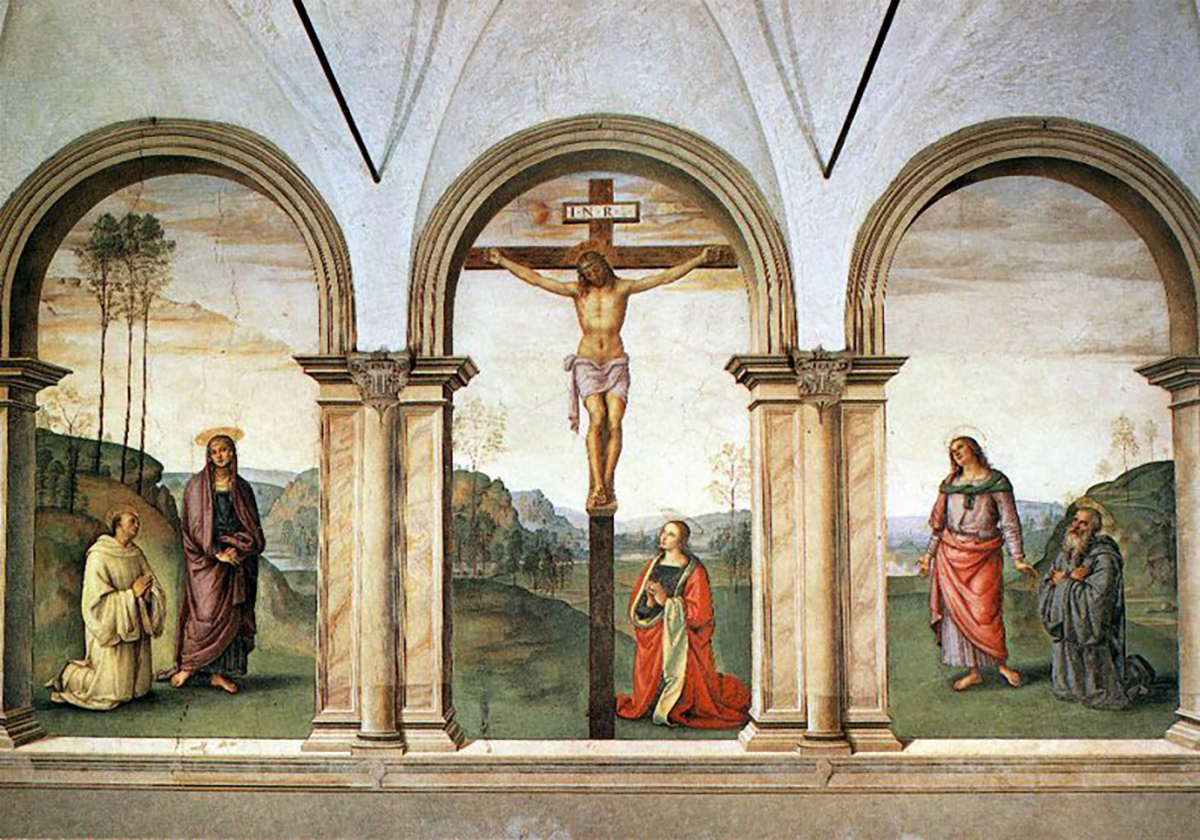
First, we plant ourselves firmly at the foot of the cross with the help of Pietro Perugino’s beautiful crucifixion painting. As we enjoy all the gentle earth tones of this fresco painting, we can begin to imagine ourselves in a full gaze of adoration demonstrated here by Mary Magdalene.
Traditionally (though probably incorrectly) believed to be the woman who bathed Jesus’ feet with her tears (Luke 7: 36-38), Mary Magdalene is often portrayed as the woman who is tearfully gazing at Jesus’ feet as he suffers on the cross. This then becomes her permanent pose in iconography. She has become the ultimate symbol of the repentant sinner who humbly and whole-heartedly worships at Jesus’ feet.
But here, Pietro Perugino, poses her differently. She is gazing upward. This sacred gesture creates an impression of complete devotion deep within our hearts. It is also marvelous to see how Perugino places her within her own space to quietly perform her personal and private act of adoration.
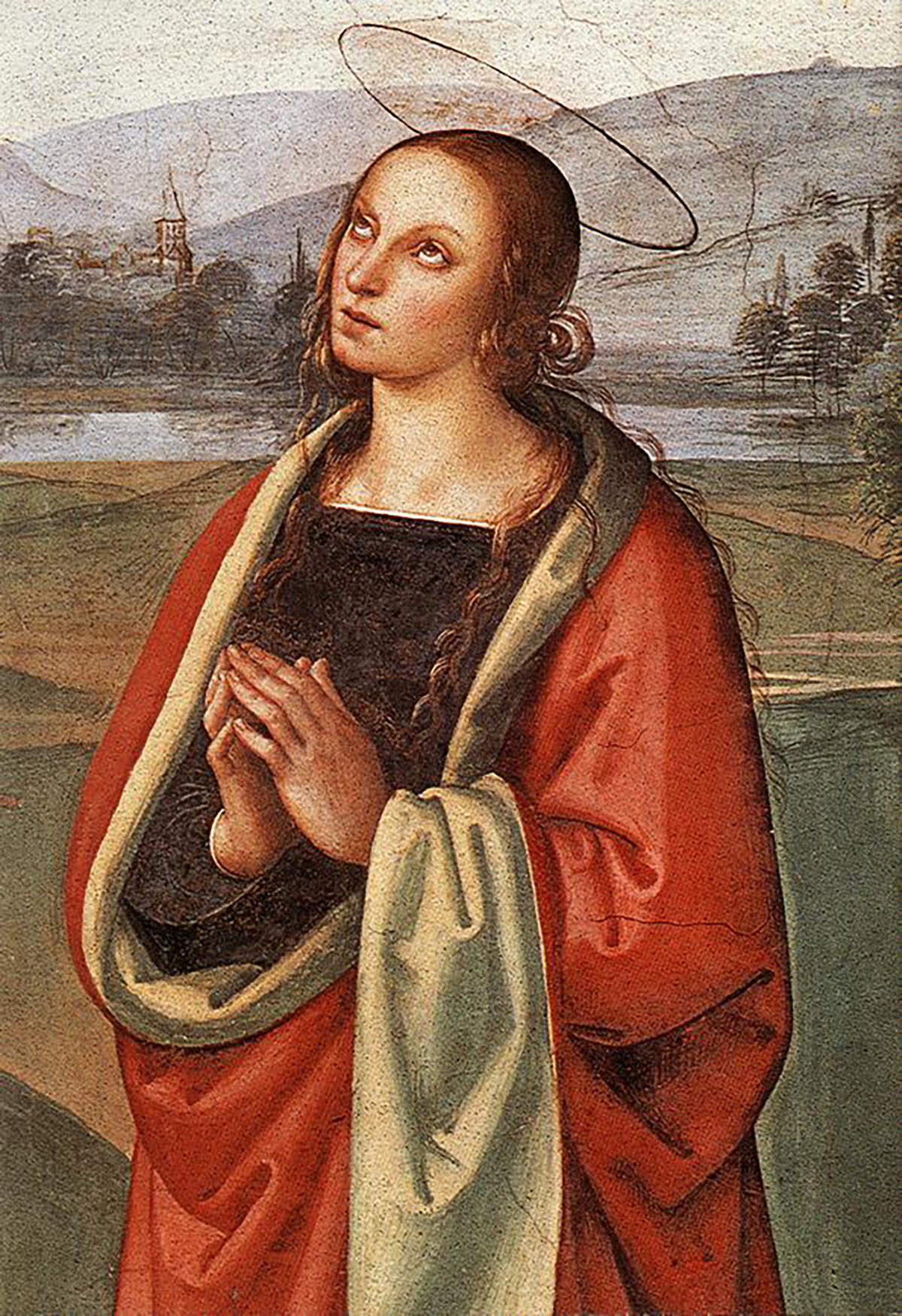
If we imagine ourselves in this sacred space, we can begin to contemplate the gift of God’s only begotten Son. Just as we are bonded to our mothers with a special kind of gratitude for the pain and suffering they have endured for us, the sight of Jesus’ suffering reminds us of the blood He shed so He might give birth to our supernatural life.
The Apostle Paul writes:
“I am not ashamed of the gospel, because it is the power of God for the salvation of everyone who believes…For in the gospel a righteousness from God is revealed, a righteousness that is by faith from first to last, just as it is written: ‘The righteous will live by faith’.” – Romans 1:16-17
However, some of us might feel a bit squeamish when it comes to talk of blood. I must admit, I need to look away when I’m having my blood drawn at the doctor’s office. And when I cut myself in the kitchen I turn into a terrible baby until I get the wound covered with a bandage. There is just something about blood that causes many of us to turn away — even from the cross. But maybe we can reexamine our feelings about blood and think of it in a new way. The next painting can help us do this.
2The Crucifixion with the Virgin Mary and Saint John the Evangelist Mourning by Rogier van der Weyden
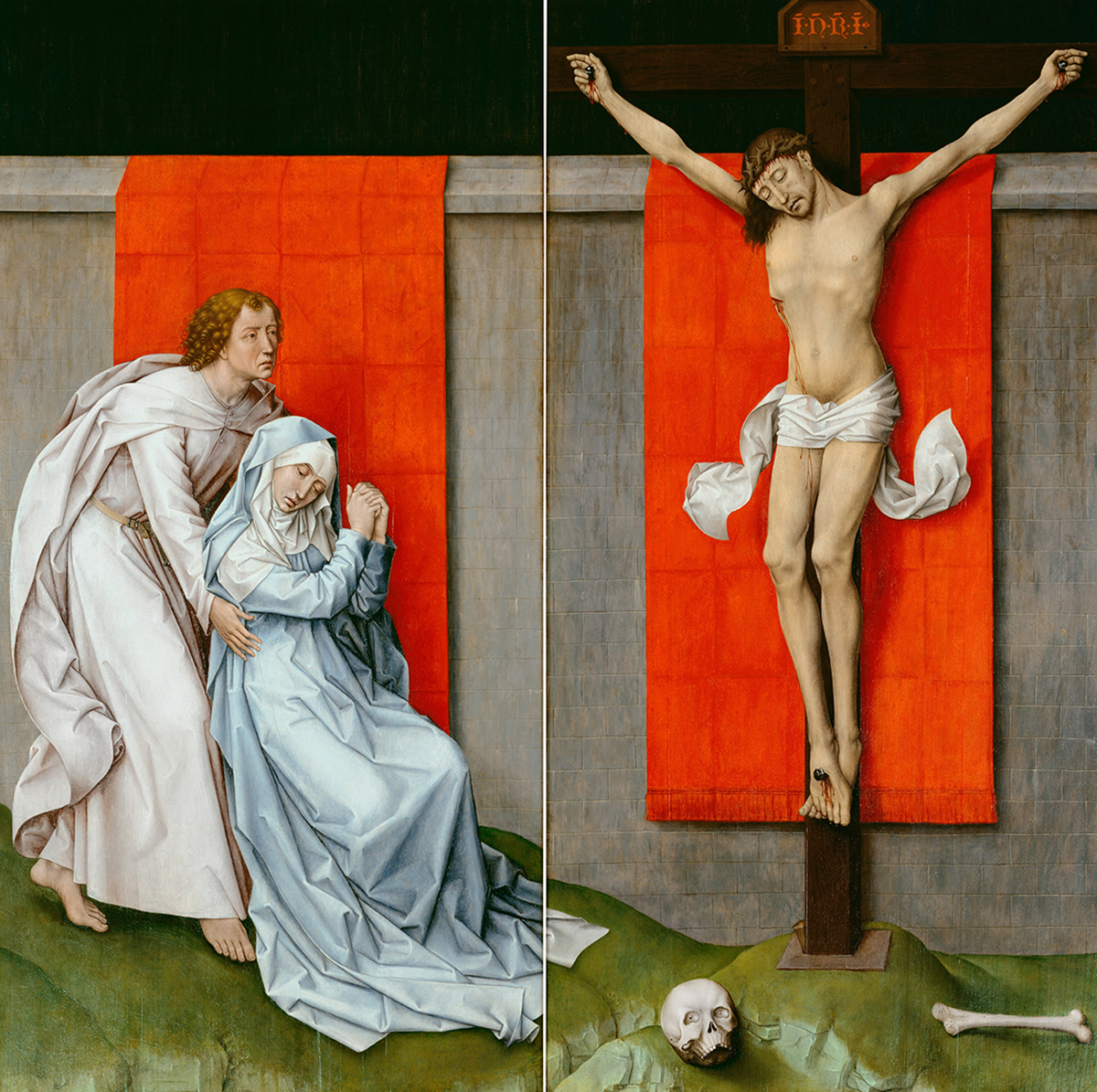
Here we explorethe Crucifixion painting by Rogier van der Weyden (1399-1464).
Weyden creates a surprisingly modern impression by placing a solid red blanket behind Christ’s bleeding body. It is this red that captures our attention and cries out with a rich expression of symbolic meaning. Lingering here, we can recall that red is the color of blood, passion, sacrifice, and even love.
Since blood is Christ’s gift to us and the source of our grace, maybe we can push our negative thoughts aside. Lingering over this imagine, we can recall that blood is life giving. Our blood runs through our veins and cleanses our body while bringing important nutrients to our organs. Simply said, without it we fail to thrive; deprived of it we die. Our blood also carries our ancestry. Blood is personal and essential to our health and well-being.
Considering this, think how Jesus’ blood cleanses us from our sin and nourishes us with his divine spiritual DNA so that we might inherit eternal life. Now listen for “the color red” in the following scripture:
“For you know that is was not with perishable things such as silver or gold that you were redeemed from the empty way of life handed down to you from your forefathers, but with the precious blood of Christ, a lamb without blemish or defect … Now that you have purified yourselves by obeying the truth so that you have sincere love for your brothers, love one another deeply from the heart. For you have been born again, not of perishable seed but of imperishable, through the living and enduring word of God.” – 1 Peter 1:18-23
3The Sacrifice of Jesus Christ, Son of God, Gathering and Protecting Mankind by Fran Floris
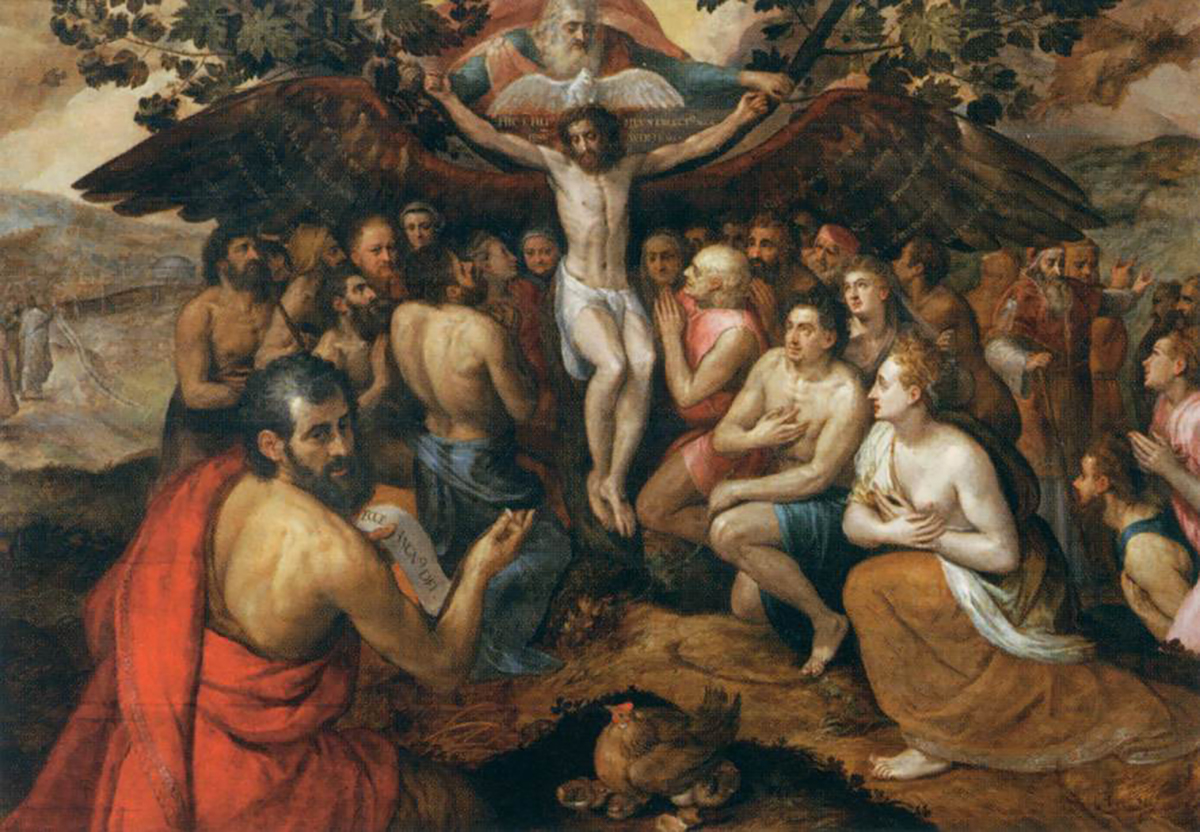
Finally, Flemish painter Frans Floris (1519/20-1570) calls us to consider a surprising perspective of God as we view Jesus’ sacrifice on the cross. Floris is asking us to consider Christ’s crucifixion as a type of window into the “surprising nature of God.”
We often allow God to do surprising things in the Scriptures, but when it comes to our everyday lives we paint Him with more predictable hues. Instead of this, maybe we can begin to imagine God in surprising ways. Armed with the knowledge that Jesus taught such things as forgiving “seventy times seven” (Matthew 18:22) or “the last will be first and the first will be last” (Matt 20:16) and “Truly the tax collectors and the prostitutes are entering the kingdom of God ahead of you.” (Matt 21:31). There certainly is reason to believe God likes to surprise us.
Imagine how awesome it will be on that fine day when Jesus Christ, the Lamb of God who takes away the sins of the world, oversees the world’s judgment. Seeing this painting encourages us to dreamof a time when we will experience the fulfillment of God’s heart, gathering us to Him like a mother hen.
“O Jerusalem, Jerusalem, you who kill the prophets and stone those sent to you, how often I have longed to gather your children together, as a hen gathers her chicks under her wings …”- Matt 23:37.
Let these meditations inspire us to act in surprising ways this Lenten season. May we let our light shine into the world to reveal God’s glorious banquet, and let us perceive with our inner eyes of faith the sumptuous table He has spread before us.
“You prepare a table before me … you anoint by head with oil, my cup overflows.” – Psalm 23:5

Read more:
12 Classic songs for quarantine kitchen dance parties

Read more:
Catholic artist livestreams concerts during time of isolation
